August 1980 lunar eclipse
A penumbral lunar eclipse took place on August 26, 1980. This subtle penumbral eclipse eclipse may have been visible to a skilled observer at maximum eclipse. 70.891% of the Moon's disc was partially shaded by the Earth (none of it was in total shadow), which caused a gentle shadow gradient across its disc at maximum; the eclipse as a whole lasted 3 hours, 34 minutes and 26 seconds.[1]

Visibility

Related lunar eclipses
Lunar year series
| Lunar eclipse series sets from 1977–1980 | ||||||||
|---|---|---|---|---|---|---|---|---|
| Ascending node | Descending node | |||||||
| Saros | Date Viewing |
Type Chart |
Gamma | Saros | Date Viewing |
Type Chart |
Gamma | |
| 112 | 1977 Apr 04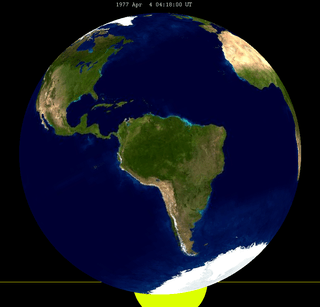 |
Partial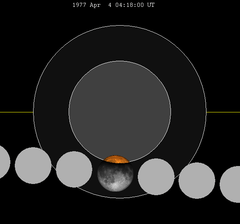 |
-0.91483 | 117 | 1977 Sep 27 |
Penumbral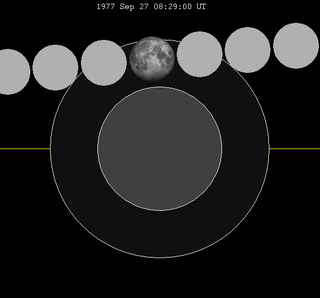 |
1.07682 | |
| 122 | 1978 Mar 24 |
Total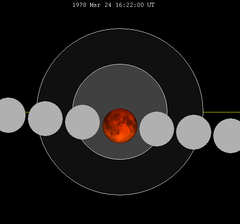 |
-0.21402 | 127 | 1978 Sep 16 |
Total |
0.29510 | |
| 132 | 1979 Mar 13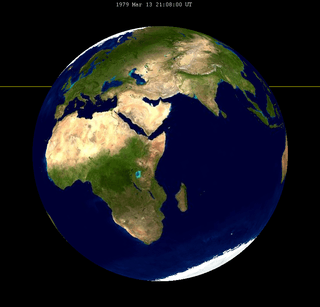 |
Partial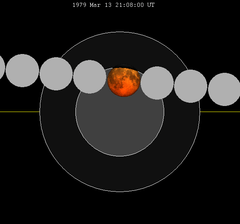 |
0.52537 | 137 | 1979 Sep 06 |
Total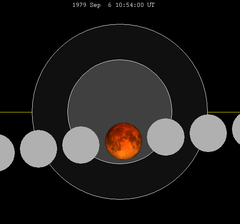 |
-0.43050 | |
| 142 | 1980 Mar 01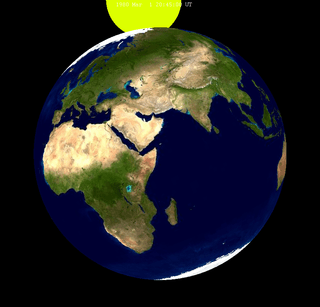 |
Penumbral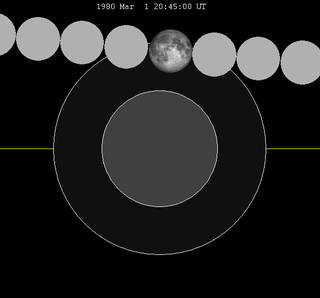 |
1.22701 | 147 | 1980 Aug 26 |
Penumbral |
-1.16082 | |
| Last set | 1976 May 13 | Last set | 1976 Nov 06 | |||||
| Next set | 1981 Jan 20 | Next set | 1980 Jul 27 | |||||
Half-Saros cycle
A lunar eclipse will be preceded and followed by solar eclipses by 9 years and 5.5 days (a half saros).[2] This lunar eclipse is related to two partial solar eclipses of Solar Saros 154.
| August 20, 1971 | August 31, 1989 |
|---|---|
 |
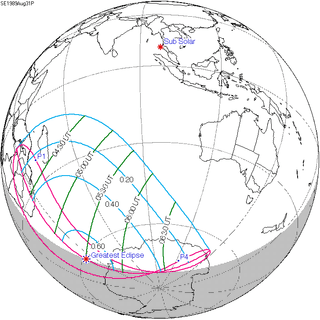 |
gollark: Also TVs.
gollark: Samsung license core designs from ARM, tweak them slightly, put them in a chip with important stuff like modems and RAM interfaces, make them, and put them in phones.
gollark: And probably some reference boards, but mostly those.
gollark: ARM only make core designs.
gollark: They have their own silicon fabs and mobile SoCs.
See also
- List of lunar eclipses
- List of 20th-century lunar eclipses
Notes
- Hermit Eclipse: Saros cycle 147
- Mathematical Astronomy Morsels, Jean Meeus, p.110, Chapter 18, The half-saros
This article is issued from Wikipedia. The text is licensed under Creative Commons - Attribution - Sharealike. Additional terms may apply for the media files.